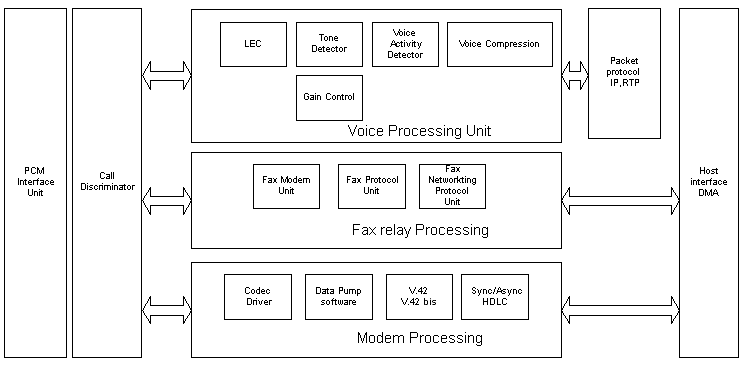GAO VoIP Software Solution
GAO offers systems designers and engineers a complete VoIP packaged solution, which includes modules for fax and data over IP. This reduces development time and time to market. The typical components of an IP Telephony System are User Interface, Voice Processing, Network Protocols, Network Management, and System Services.
GAO offers the following modules as part of the VoIP package:
| Voice Processing | |
|---|---|
| Call Discrimination | Detection of a voice, fax, or data call so that it can be switched to the appropriate functional module. |
| Echo Cancellation (DNEC) | Digital network echo cancellation according to G.168 |
| Voice activity detection (VAD) and Comfort noise generation (CNG) | Voice connections are almost entirely one-way. GAO VoIP software halves the transmission bandwidth by recognizing the periods when a party is silent and ceasing transmission during those periods. Comfort noise generation is also provided |
| Tone Detection/Generation | DTMF detection/generation |
| Automatic Gain Control (AGC) | AGC adaptively controls the dynamic range of a speech signal without amplifying the noise between words and phrases. |
| Speech Vocoder (audio codecs) | Any of GAO's speech codecs can be chosen from G.711, G.722, G.726, G.723.1, G.729A, G.729AB |
| Fax Processing | |
| T.38 Fax Protocol | T38 fax over IP software allows the transfer of facsimile documents in real-time between two standard Group3 facsimile (G3 fax) terminals over the Internet or other networks using IP protocols. It is fully compliant with ITU-T T.38 fax relay specification. |
| V.17, V.29, V.27ter, V.21 Ch.2 Fax Data Pump | GAO G3 Fax Package includes V.17, V.29, V.27 ter, and V.21 ch.2. |
| Packet Transmission and Control | |
| Lost packet detection and reconstruction | GAO VoIP products detect when packets are lost and reconstructs them either by repeating information in subsequent frames or using an upper layer protocol, i.e. TCP |
| Jitter buffer management and sequencing | Packets are stored in a jitter buffer and sequenced so that the slower packets can catch up to the conversation. |
| Packet protocol | The Packet Protocol module receives signaling information that has been interpreted by the Telephony Processing module and converts it from the telephony signaling protocols to the specific packet signaling protocol that is used to set up connections over the data network. It also adds appropriate protocol headers to both voice and signaling packets before transmission. |
| Modem Unit | |
| V.90, V.34 Modem Data Pump | GAO V.90 software module can connect at data rates of up to 56 Kbps. GAO V.34 software modem can connect at data rates of up to 33.6 Kbps. |
| V.44 Data Compression | ITU-T V.44 Data compression procedures |
| V.42 Error Correction | ITU-T V.42 error-correcting procedures for DCE using asynchronous-to-synchronous conversion |
| Network Protocols and Management | |
| H.323 | GAO's implementation of H.323 protocol stack complies with ITU-T Recommendation H.323. The H.323 protocol stack is a complete, integrated suite of protocols that defines every component of a conferencing network: terminals, gateways, gatekeepers, MCUs and other feature servers. |
| SIP | GAO's implementation of the SIP protocol stack complies with IETF RFC2543, and is modified as per the updates of the standard. The stack offers carrier class performance and functionality to manage the fundamental connection between the call-originating and call-terminating parties. |
GAO VoIP Software Architecture

IP telephony can yield big cost savings to both corporations and consumers. Because information travels in discrete packets, it does not need to rely on a continuously available switched circuit; consequently, it is very bandwidth-efficient and cost-effective. IP telephony commonly takes as little as one-twelfth the bandwidth of the Plain Old Telephone Service (POTS) to transmit conversations.
For a complete list of GAO’s Speech Vocoders Software products, please see GAO’s Speech Vocoders List.
For a complete list of GAO’s Telephony Software products, please see GAO’s Telephony Software.
GAO’s rigorous testing standards
